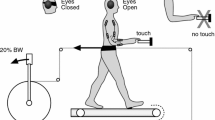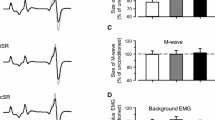Abstract
To investigate the influence of load on the modulation of cutaneous reflexes, evoked by sural nerve stimulation, electromyographic activity in different leg muscles (tibialis anterior, gastrocnemius medialis (GM), biceps femoris, and soleus muscles (SO)) was recorded in healthy humans during treadmill walking with different body loads. Sural nerve stimulation was applied at two times perception threshold during different phases of the step cycle. Reflex amplitudes increased with body unloading and decreased with body loading. The reflex responses were not a simple function of the level of background activity. For example, in GM and SO, the largest reflex responses occurred during walking with body unloading, when background activity was de-creased. Hence, stable ground conditions (body loading) yielded smaller reflexes. It is proposed that load receptors are involved in the regulation of cutaneous reflex responses in order to adapt the locomotor pattern to the environmental conditions.
Similar content being viewed by others
References
Brooke JD, Cheng J, Collins DF, Mcllroy WE, Misiaszek JE, Staines WR (1997) Sensori-sensory afferent conditioning with leg movement: gain control in spinal reflex and ascending paths. Prog Neurobiol 51:393–421
Clement G, Gurfinkel VS, Lestienne F, Lipshits MI, Popov KE (1984) Adaptation of postural control to weightlessness. Exp Brain Res 57:61–72
Conway BA, Hultborn H, Kiehn O (1987) Proprioceptive input resets central locomotor rhythm in the spinal cat. Exp Brain Res 68:643–656
Danion F, Bonnard M, Pailhous J (1995) Joint-dependent mechanisms to adapt to an imbalance between flexion and extension forces in human gait. Neurosci Lett 187:185–188
Danion F, Bonnard M, Pailhous J (1997) Intentional on-line control of propulsive forces in human gait. Exp Brain Res 116:525–538
Dietz V (1992) Human neuronal control of automatic functional movements: interaction between central programs and afferent input. Physiol Rev 72:33–69
Dietz V, Colombo G (1998) Influence of body load on the gait pat-tern in Parkinson’s disease. Mov Disord 13:255–261
Dietz V, Gollhofer A, Kleiber M, Trippel M (1992) Regulation of bipedal stance: dependency on “load” receptors. Exp Brain Res 89:229–231
Duysens J, Pearson KG (1980) Inhibition of flexor burst generation by loading ankle extensor muscles in walking cats. Brain Res 187:321–332
Duysens J, Trippel M, Horstmann GA, Dietz V (1990) Gating and reversal of reflexes in ankle muscles during human walking. Exp Brain Res 82:351–358
Duysens J, Tax AA, Doelen B van der, Trippel M, Dietz V (1991) Selective activation of human soleus or gastrocnemius in reflex responses during walking and running. Exp Brain Res 87:193–204
Duysens J, Tax AA, Trippel M, Dietz V (1992) Phase-dependent reversal of reflexly induced movements during human gait. Exp Brain Res 90:404–414
Duysens J, Tax AA, Trippel M, Dietz V (1993) Increased amplitude of cutaneous reflexes during human running as compared to standing. Brain Res 613:230–238
Duysens J, Tax AA, Murrer L, Dietz V (1996) Backward and forward walking use different patterns of phase-dependent modulation of cutaneous reflexes in humans. J Neurophysiol 76:301–310
Duysens J, Clarac F, Cruse H (2000) Load regulating mechanisms in gait and posture: comparative aspects. Physiol Rev 80:83–133
Faist M, Dietz V, Pierrot-Deseilligny E (1996) Modulation, probably presynaptic in origin, of monosynaptic la excitation during human gait. Exp Brain Res 109:441–449
Faist M, Blahak C, Duysens J, Berger W (1999) Modulation of the biceps femoris tendon jerk reflex during human locomotion. Exp Brain Res 125:265–270
Finch L, Barbeau H, Arsenault B (1991) Influence of body weight support on normal human gait: development of a gait retraining strategy. Phys Ther 71:842–855
Fouad K, Pearson KG (1997) Effects of extensor muscle afferents on the timing of locomotor activity during walking in adult rats. Brain Res 749:320–328
Ghori GM, Luckwill RG (1985) Responses of the lower limb to load carrying in walking man. Eur J Appl Physiol 54:145–150
Gossard JP, Brownstone RM, Barajon I, Hultborn H (1994) Trans-mission in a locomotor-related group Ib pathway from hind-limb extensor muscles in the cat. Exp Brain Res 98:213–228
Harkema SJ, Hurley SL, Patel UK, Requejo PS, Dobkin BH, Edgerton VR (1997) Human lumbosacral spinal cord interprets loading during stepping. J Neurophysiol 77:797–811
Hiebert GW, Pearson KG (1999) Contribution of sensory feedback to the generation of extensor activity during walking in the de-cerebrate cat. J Neurophysiol 81:758–770
Hultborn H, Illert M, (1991) How is motor behaviour reflected in the organization of spinal systems? In: Humphrey DR (ed) Motor control: concepts and issues. Wiley, New York, pp 49–73
Jankowska E (1992) Interneuronal relay in spinal pathways from proprioceptors. Prog Neurobiol 38:335–378
McCrea DA (1998) Neuronal basis of afferent-evoked enhancement of locomotor activity. Ann N Y Acad Sci 860:216–225
Menard A, Leblond H, Gossard JP (1999) The modulation of pre-synaptic inhibition in single muscle primary afferents during fictive locomotion in the cat. J Neurosci 19:391–400
Pearson KG (1995) Proprioceptive regulation of locomotion. Curr Opin Neurobiol 5:786–791
Pearson KG, Ramirez JM, Jiang W (1992) Entrainment of the locomotor rhythm by group Ib afferents from ankle extensor muscles in spinal cats. Exp Brain Res 90:557–566
Pearson KG, Misiaszek JE, Fouad K (1998) Enhancement and resetting of locomotor activity by muscle afferents. Ann N Y Acad Sci 860:203–215
Rossi A, Decchi B (1994) Flexibility of lower limb reflex responses to painful cutaneous stimulation in standing humans: evidence of load-dependent modulation. J Physiol 481:521–532
Stein RB (1995) Presynaptic inhibition in humans. Prog Neurobiol 47:533–544
Stephens MJ, Yang JF (1999) Loading during the stance phase of walking in humans increases the extensor EMG amplitude but does not change the duration of the step cycle. Exp Brain Res 124:363–370
Tax AAM, Wezel BHM van, Dietz V (1995) Bipedal reflex coordination to tactile stimulation of the sural nerve during human running. J Neurophysiol 73:1947–1964
Van de Crommert HW, Faist M, Berger W, Duysens J (1996) Biceps femoris tendon jerk reflexes are enhanced at the end of the swing phase in humans. Brain Res 734:341–344
Whelan PJ (1996) Control of locomotion in the decerebrate cat. Prog Neurobiol 49:481–515
Whelan PJ, Hiebert GW, Pearson KG (1995) Stimulation of the group I extensor afferents prolongs the stance phase in walking cats. Exp Brain Res 103:20–30
Yang JF, Stein RB (1990) Phase-dependent reflex reversal in human leg muscles during walking. J Neurophysiol 63:1109–1117
Yang JF, Stephens MJ, Vishram R (1998) Transient disturbances to one limb produce coordinated, bilateral responses during infant stepping. J Neurophysiol 79:2329–2337
Zehr EP, Stein RB, Komiyama T (1998) Function of sural nerve reflexes during human walking. J Physiol 507:305–314
Author information
Authors and Affiliations
Corresponding author
Additional information
Published online: 15 August 2000
Rights and permissions
About this article
Cite this article
Bastiaanse, C.M., Duysens, J. & Dietz, V. Modulation of cutaneous reflexes by load receptor input during human walking. Exp Brain Res 135, 189–198 (2000). https://doi.org/10.1007/s002210000511
Received:
Accepted:
Issue Date:
DOI: https://doi.org/10.1007/s002210000511




